|
||
|
|
To indicate that the work necessary for a particular process state has been completed you should use the Task operation.
There are various ways to perform the Task operation:
From a report on the Home or Query pages:
Click on the Task icon to the left of a record in the report.

Using the Task icon in the Button bar:
Click on the Task icon on the Button bar at the top. The Search
Window will appear. You can enter the record number you would like to
see and click Go to see the list of transitions available for the record
number specified.
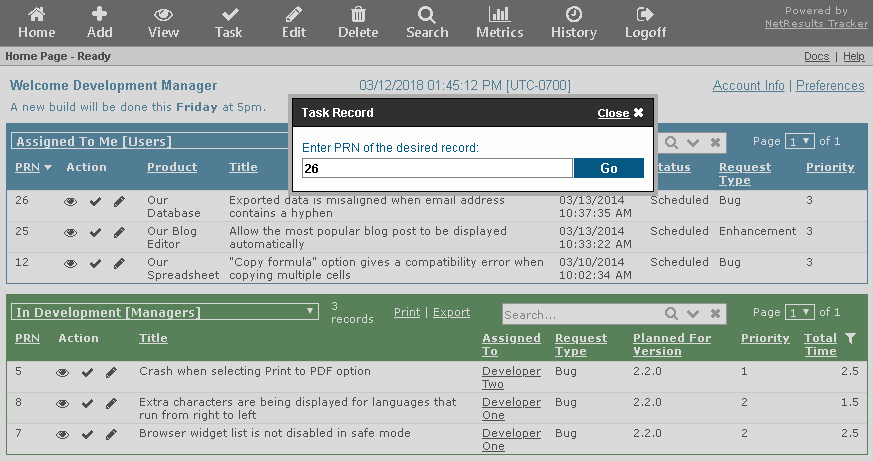
Depending upon the current state, there may be one or more choices displayed in order to mark a task complete. The choices, called Transitions, can be displayed as clickable buttons, radio buttons, or a pulldown menu.
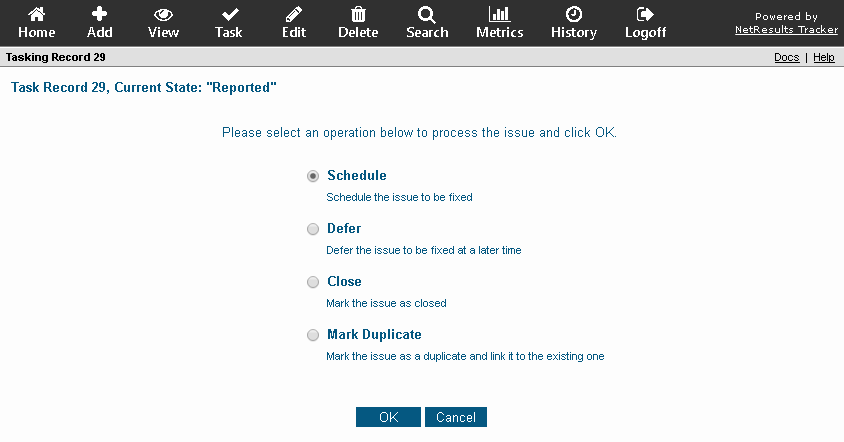
Once you select a choice, the next screen will show the appropriate fields required to be filled out for completing a task.
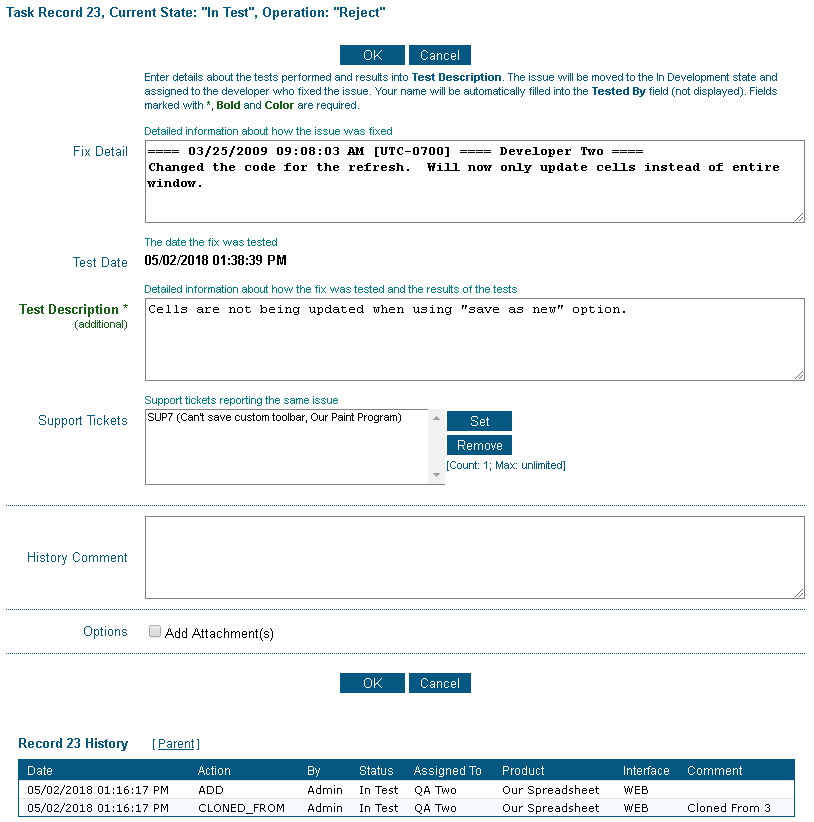
Fields and / or a history comment may be displayed after selecting a transition. The fields presented are called task fields. Some of these fields may be for your information only (read-only task fields) and cannot be modified. Other fields including the history comment may require a modification before you can click OK to proceed. Depending on how your Tracker has configured the system, there may be some text above the task fields to explain which are required. For example, the following text or something similar can be displayed to identify required fields: "Fields marked with *, Bold and Color are required fields."
The field help will be displayed if you have checked the
box for the Enable Field Help
preference
and your Tracker Administrator has entered information to describe
this field. If a Field Help icon  is displayed, move your cursor over the icon to see a description
of the field.
is displayed, move your cursor over the icon to see a description
of the field.
When a date field is present during the Task operation, you can click on the calendar icon to select a date or you can manually enter a date in the appropriate format (e.g. "mm/dd/yyyy HH:MM:SS AM/PM" or the date & time format selected in the Preferences section.). The time component is optional. Click on the day to select the date to be entered into the date field. Click < or > to move backward or forward one month or click << or >> to move backward or forward one year. Click Now to set the date field to be the current date and time. Click on Exclude Time if you want to exclude the time information from being saved in the date field. For a field where the time information has previously been excluded, click Set Time if you wish to include the current time information in the field. Click OK to choose the highlighted date to be entered into the date field. Date will be selected and calendar dismissed when a date is clicked when the time is excluded. Dates displayed in red are non-business days according to the Business Days option in the Preferences section. Click Cancel to dismiss the calendar without saving changes.
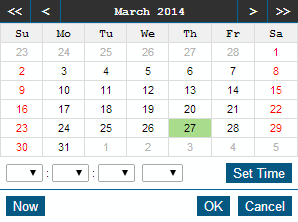
When large text fields are present, an Annotate button may be displayed to the left of the field. Clicking on the Annotate button will add a date and time stamp with your User ID to the field. This makes it easy to distinguish which information within the field has been added by you or another user.
To view the full contents of the large text fields, use the scroll bar on the right of the field. Alternatively, the number of lines displayed for these large text fields can be customized by setting the value of the Display Window option in the Multi-line Field Settings section on your Preferences page.
When a pulldown field is present, it may be displayed as a traditional pulldown, radio buttons, vertical radio buttons or a search pulldown. When a field is displayed as a search pulldown, you can enter key words to find any option menu items that match your criteria. To make a selection in a search pulldown, click on the Set button to the right of the field, type in one or more key words and click on the Find button. Any items that matched your criteria will be displayed, click on the item you wish to select, then click on the Set button (or simply double click on the item you wish to select).
Your Tracker may have been configured to have dependent pulldown fields. Dependent pulldowns are pulldown fields where the option menu values displayed in one pulldown are determined by the value selected in the pulldown it is dependent on. If you change the value selected in a parent pulldown field, it may change the values available in the child pulldown menu based on the relationship set up between the two fields.
Link fields are fields that allow records to be linked to one another. For example, if different types of forms are available in your Tracker workgroup, your Tracker Administrator may have set up Link field so records created by one form can be linked to records created using another form. When a Link field is presented during the Task operation, any records that have been linked will be displayed. To add items to the Link field, click on the Set button. A list of items that can be added will be displayed (if you are using a browser other than Internet Explorer, the list will not be displayed until you click on the Find button). To search for items using a key word(s), type the key word(s) into the Search Criteria field and click on the Find button. Any items that matched your key word(s) will be displayed. The key word(s) are searched within the key fields for the forms you are searching. Because Tracker can support multiple projects and forms, the Tracker Administrator can select key fields when creating a form. To find out which fields are the key fields for a certain form, go to the View Page for a record. The values of the key fields will be displayed in bold. In the View Page sample, the fields "PRN" and "Title" are the key fields as their values are displayed in bold. When a Release Number field is a key field, the value you enter into the Search text box will be searched within each individual digit of the Release Number field. For example, you can search using values like "1", "Beta 2", etc. Basically, you can search for the items that are configured as choices in the Release Number field. However, you cannot search for a combination of multiple digits at once. For example, if you enter "1.2" into the Search text box in an attempt to find records that have values like "1.2.0.None", "1.2.0.Beta 1", "1.2.1.-", you will get 0 matches because it will search for the value "1.2" within each individual digit of the Release Number. To select an item, click on the item. To select multiple items, hold down the Ctrl button on your keyboard while clicking on the items to be added. Click on the Add or Set button to add the selected items to the Link field. To remove items from the Link field, click on the item, then click on the Remove button. To select multiple items, hold down the Ctrl button on your keyboard while clicking on the items to be deleted.
If the Link Field has been configured to allow more than one item to be linked, you will see the total number of items that are currently linked ("Count") and the maximum number of items ("Max") that can be linked below the Set and Remove buttons.
Your Tracker Administrator may have configured the transition to display the record's history below the task fields.
If your Tracker Administrator has configured the transition you selected to allow attachments to be saved to the record, the option Add Attachment(s) will be available. Check the box for this option if you wish to save an attachment to the record you are processing. To add a File or URL attachment to the record:

If your Tracker Administrator has configured the transition you selected to allow source code files to the associated to the record, the option Associate Source Code File(s) will be available. Check the box for this option if you wish to associate source code files to the record you are processing. To associate a source code file to a record:
Note that once you click OK to complete the Task operation, Tracker automatically advances the record to the next process state, and assigns the record to the next appropriate user.
If your Tracker Administrator has configured the transition you selected to "clone" (create a copy of) the record you originally selected, the Task operation will first create a copy of the original record, then the Task operation will be performed on the clone (child record). All of the fields you update (Task Fields) and other changes (such as assignment and status changes) that are made by the Task operation will be made to the clone. When a Task operation that clones a record completes, the record number that is displayed will be the record number of the (newly created) clone, not the (parent) record you originally selected. Typically, the Transition name will also reflect the fact that a clone operation will be done (e.g. "Copy Record", "Add Subtask", etc.). Review the Cloning a Record, section of the View page Help for further information on record cloning.
After clicking on the OK button, if your Tracker workgroup is set up to send email notification messages when a record has been processed using the Task operation, you will see a message "Sending Email Notifications...Please wait". This message indicates that the changes to the record have been saved and Tracker is sending the email notification messages.
Alerts are email notification messages that can be configured for a record. You can set an alert to remind you about a particular record at a later date and time. You can also set an alert to be sent to other users and groups in your organization.
If you have been given the appropriate privileges, you may be given the option to set an alert during the Task operation as shown below. Details on how to configure Alert settings during the Task operation can be found in the Alerts section.
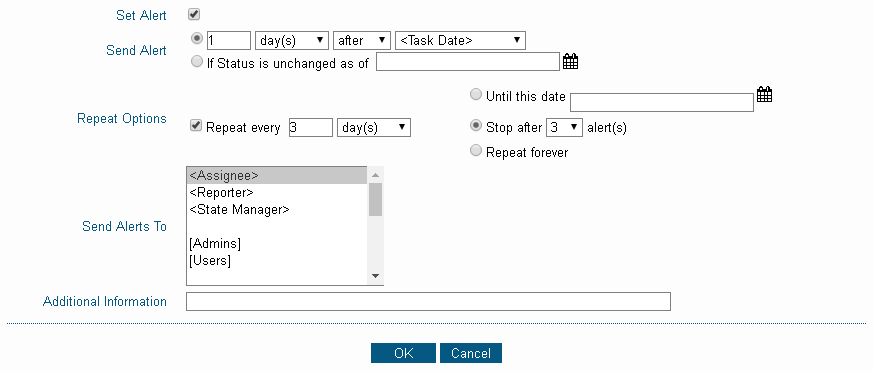
NetResults Tracker © 1997-2020 NetResults Corporation. All rights reserved.
Need Support? Chat now...